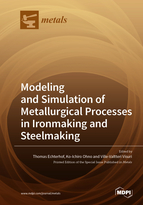Modeling and Simulation of Metallurgical Processes in Ironmaking and Steelmaking
A special issue of Metals (ISSN 2075-4701). This special issue belongs to the section "Computation and Simulation on Metals".
Deadline for manuscript submissions: closed (31 March 2022) | Viewed by 48412
Special Issue Editors
Interests: EAF steelmaking; industrial furnaces; process modelling and simulation; process analysis and optimization
Special Issues, Collections and Topics in MDPI journals
Interests: blast furnace; iron ore sintering; iron ore granulation; iron ore reduction reaction; self-reducing pellet; carbothermic reduction; cohesive zone; iron carburization behavior; iron ore softening and melting behavior
Special Issues, Collections and Topics in MDPI journals
Interests: hot metal pretreatments; electric arc furnaces; converter metallurgy; ladle metallurgy; continuous casting; process modelling and simulation; kinetics and thermodynamics of metallurgical processes
Special Issues, Collections and Topics in MDPI journals
Special Issue Information
Dear Colleagues,
The UN’s 2030 Sustainable Development Goals, the Paris Agreement, and the European Green Deal, among other goals, all aim to improve the sustainability of industrial production and to reduce CO2 emissions. Europe, for example, aims to reach carbon neutrality and a circular economy by 2050. This goal cannot be achieved without the ironmaking and steelmaking industries.
To reach this goal, further process optimizations with regard to energy and resource efficiency, as well as the development of new processes or process routes, are needed. However, the parameters necessary for the analysis and optimization of the existing and new metallurgical processes in ironmaking and steelmaking often cannot be measured directly because of the harsh conditions inside the furnaces and metallurgical vessels.
Typically, the direct information sources in ironmaking and steelmaking are off-gas analysis and spot measurements, for which a delay for the analysis of the sample must be reserved. Owing to the harsh environment, possibilities to determine the flow conditions in the vessels by measurements are even more limited.
While new methods for the direct and continuous measurement of some of these parameters are currently under development, for many processes they are not available at this time. Furthermore, plant trials that would be necessary to evaluate the impact of different optimization strategies may be impossible because of the prohibitive cost or safety concerns in many cases.
Modeling and simulation have thus established themselves as an invaluable source of information regarding otherwise unknown process parameters, and as an alternative to plant trials with a lower associated cost, risk, and duration. Models are also applicable for model-based control of metallurgical processes.
In this Special Issue on “Modeling and Simulation of Metallurgical Processes in Ironmaking and Steelmaking”, we aim to collect regular and review articles to showcase the recent advances in the modeling and simulation of unit processes in ironmaking and steelmaking, while considering the latest experimental results and process operational data. We also encourage studies that examine the integration of process models to simulate process chains.
Dr. Thomas Echterhof
Prof. Ko-Ichiro Ohno
Dr. Ville-Valtteri Visuri
Guest Editors
Manuscript Submission Information
Manuscripts should be submitted online at www.mdpi.com by registering and logging in to this website. Once you are registered, click here to go to the submission form. Manuscripts can be submitted until the deadline. All submissions that pass pre-check are peer-reviewed. Accepted papers will be published continuously in the journal (as soon as accepted) and will be listed together on the special issue website. Research articles, review articles as well as short communications are invited. For planned papers, a title and short abstract (about 100 words) can be sent to the Editorial Office for announcement on this website.
Submitted manuscripts should not have been published previously, nor be under consideration for publication elsewhere (except conference proceedings papers). All manuscripts are thoroughly refereed through a single-blind peer-review process. A guide for authors and other relevant information for submission of manuscripts is available on the Instructions for Authors page. Metals is an international peer-reviewed open access monthly journal published by MDPI.
Please visit the Instructions for Authors page before submitting a manuscript. The Article Processing Charge (APC) for publication in this open access journal is 2600 CHF (Swiss Francs). Submitted papers should be well formatted and use good English. Authors may use MDPI's English editing service prior to publication or during author revisions.
Keywords
- Mathematical modeling
- Physical modeling
- Computational fluid dynamics
- Process metallurgy
- Ironmaking
- Steelmaking
- Data-driven modelling
- Kinetics
- Thermodynamics








